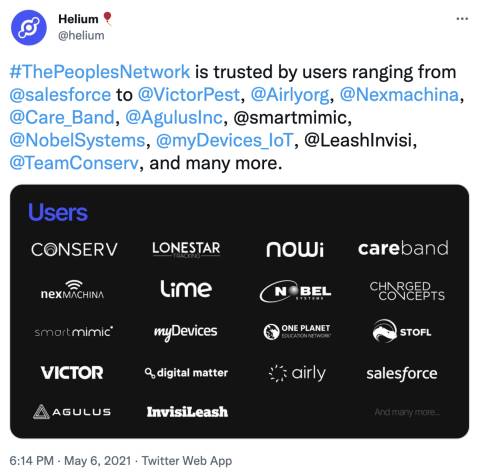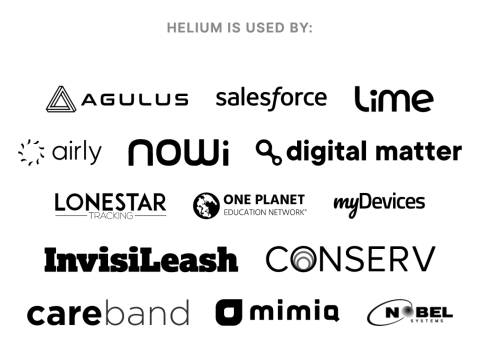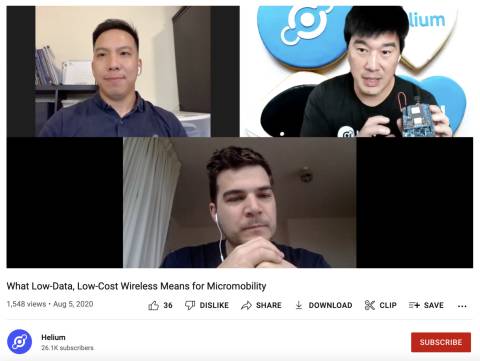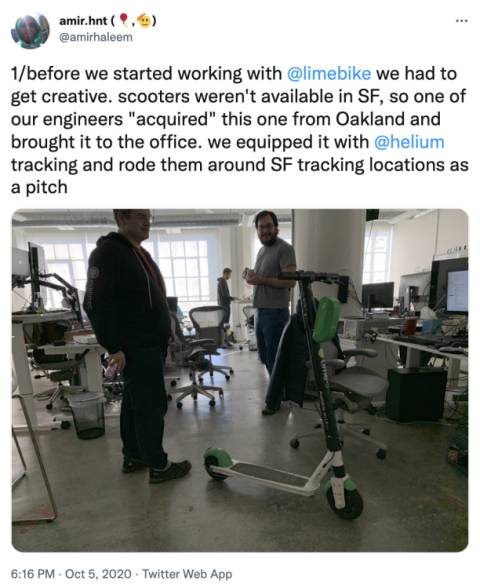Helium is often heralded as one of the largest success stories in the Web3 space, even landing a coveted article in The New York Times earlier this year. Since 2019, the decentralized wireless network service, which bills itself as a peer-to-peer network for the Internet of Things, has touted rideshare company Lime as one of its marquee clients, claiming the company uses its service to geolocate rentable escooters. There are numerous mentions of this partnership on its website, along with the presence of Lime's company logo, and in press coverage with various news outlets.

There's just one problem: That partnership never really existed.

Beyond an initial test of its product in 2019, Lime has not had, and does not currently have, a relationship with Helium. Lime senior director for corporate communications Russell Murphy said to Mashable.

According to Murphy, there was a brief test of [Helium's] product that didn’t last beyond a month or two in the summer of 2019. There has been no contact between Helium and Lime since then. Details surrounding what the test actually entailed are unclear, as Helium's primary contact at Lime left the company more than two and a half years ago. However, Murphy says that, as a condition of the trial, Lime had requested that its name not be used by Helium in promotional material.
Lime is listed as an active client on Helium's website. Credit: Mashable ScreenshotOn Helium's website, Lime is featured prominently, alongside Salesforce, as one of the biggest companies that uses Helium's service, and certainly the biggest in the IoT space. Beyond merely stating its service is used by Lime, Helium also boasts that it is trusted by Lime on its Enterprise webpage. In a post on Twitter from May 2021, Helium mentions how it is trusted by users and, again, includes Lime's logo on a list of its customers — but curiously omits directly tagging Lime's Twitter account.

Despite the omnipresence of this supposed partnership, executives at Lime, who were aware of this misrepresentation, had declined to take action, legal or otherwise.

Helium has been making this claim for years and it is a false claim, Murphy said.

Now, however, Mashable has learned that Lime is preparing to send a cease and desist to Helium over its use of Lime's name and logo on its website, and in its marketing.
A tweet from 2021 listed Lime as a client of Helium. Credit: Mashable ScreenshotFounded in 2013 by CEO Amir Harleem and Napster's Shawn Fanning, Helium has dubbed itself The People's Network. Ostensibly, Helium is hoping to build a network for Internet of Things devices — basically anything that requires connectivity to the internet, such as smart refrigerators or the Ring doorbell — in places with shoddy or non-existent WiFi, or 5G coverage. Helium's decentralized model calls for it to expand connectivity through multiple independent devices, rather than depend on a centralized infrastructure.
How does Helium do this? By selling hotspot devices, priced as much as $500 each, to budding investors and hopeful entrepreneurs. The hotspots also act as crypto mining hardware and reward the owners of these devices with Helium's $HNT token, which it introduced in July 2019, when a user accesses Helium's network via their hotspot device. $HNT is currently valued at approximately $9.
As of mid-2022, Helium's wireless network appears to have very few actual customers. Instead, the vast majority of Helium's revenue comes from individuals that purchase the company's hotspot devices in hopes that they will earn cryptocurrency when corporations, like Lime, utilize the network service. Helium has used Lime's image to prove the network has major clients. But, Lime does not use the service.
Lime's scooters are available in nearly 250 cities around the world. And, according to Lime spokesperson Murphy, the company has now logged more than 300 million rides on its scooters.
SEE ALSO: The biggest crypto scams of 2022 (so far)Helium has been written about extensively by cryptocurrency-centric outlets, like Coindesk, but has also received mentions in mainstream press outlets, such as Axios. Most recently, in February 2022, Helium and its COO Frank Mong were the subject of a glowing profile in The New York Times by tech columnist Kevin Roose titled Maybe There’s a Use for Crypto After All.
Lime was the first of two companies named in the Times article as an example of Helium's biggest clients.
Anyone can use the Helium network, although most of its users so far are companies like Lime (which has used Helium to keep tabs on its connected scooters), wrote Roose. It’s a real product used by real people and companies every day.
According to Lime, The New York Times did not reach out to the company to confirm the partnership. Mashable attempted to confirm this but the Times said it does not discuss sourcing. Since the article's publication, Helium has continued to promote it extensively. Helium CEO Amir Haleem has even pinned a Feb. tweet about the piece to the top of his Twitter profile.
These claims about a supposed Lime partnership are made even more interesting by an August 2020 video webinar interview, uploaded to Helium's YouTube channel, with Lime's former central operations manager Eddie Li.
In the video, host Oliver Bruce of the Micromobility Podcast asks Li if Lime ever used Helium's network.
Did Lime ever end up adopting it and putting it out in any of their scooters? asks Bruce.
I don't know now, but I think there was just a lot of projects going down, explains former Lime employee Li. After testing with Frank [Mong], there was definitely something that could have been there. But there's just so much going on at that time…there was just a lot of things that did not come to fruition with Helium.
COO Mong, who was one of the three people featured on the video podcast along with Bruce and Li, then chimes in. Mong recalled how Li had told him in 2019, when Li was still working at Lime, how Helium's tracking device wouldn't work on Lime's scooters.
Dude that's too big, we can't use that on a scooter, Mong recalled Li saying. Mong said that by the time Helium was able to get a device small enough for the scooter, Helium no longer had a contact at Lime as Li had exited the company.
Helium COO Frank Mong shows just how big Helium's tracking device was when Eddie Li (pictured: upper left), formerly of Lime, decided to forgo attaching them to Lime's escooters. Credit: Mashable ScreenshotWe still hope we can get back in with Lime, Mong said in the Aug. 5, 2020 video. According to Lime spokesperson Murphy, Li has not worked at Lime for over two years. And, even though the 2019 test fizzled, Lime remains a central part of Helium's marketing to this day.
I believe [Li] was the only person who had any meaningful interaction with Helium, says Murphy.
In November 2019, on Helium's official subreddit community on Reddit, Mong was questioned about the Lime partnership by another user in the forum.
We have worked with Lime's operations team in SF and we are in discussions to expand, he replied. They are a great group of folks! I'm guessing 'corporate' doesn't know about us because a lot of our original sponsors are no longer at the company.
SEE ALSO: Minecraft says it wants nothing to do with NFTs, blockchainWhile Helium was founded in 2013, its wireless network business model floundered until it introduced the crypto-earning aspect into the service. In July 2019, Helium would start minting its $HNT token and roll out its plan to sell hotspots in return for cryptocurrency rewards. One month earlier, in Helium's official blog, CEO Haleem would first begin mentioning a relationship with Lime. In one post from June 2019, he specifically categorized Lime as a partner.
Helium CEO Amir Haleem reminisces about a testing phase before we started working with Lime in an Oct. 2020 tweet. Credit: Mashable ScreenshotMore than a year after that short testing phase in 2019, Helium's CEO would, once again, post about a relationship with Lime, this time on Twitter. In an Oct. 5, 2020 tweet, Haleem shared how Helium acquired Lime scooters off the street in Oakland, CA in order to equip them with the company's GPS trackers.
before we started working with @limebike we had to get creative, Haleem tweeted, insinuating that the two companies' involvement, which never lasted beyond that initial trial, was still in existence more than a year later.
When reached for comment, a spokesperson for Nova Labs, Helium's parent company, provided Mashable with the following statement:
Nova Labs worked with Lime operations out of their San Francisco HQ. They trialed Lime scooters with the Helium Network using LoRaWAN tracking devices to find lost or stolen scooters, and were impressed with the accuracy of the sensors and vast coverage. Lime has since restructured and the team members we worked with are no longer employed there.
Mashable also reached out to former Lime central operations manager Eddie Li for comment. We will update this article when we hear back.
On its Enterprise webpage, Helium claims it is trusted by Lime. Credit: Mashable ScreenshotIn the Web3 space, Helium has been held up as a unicorn, a common VC term to describe a startup company with a value of over $1 billion. The Web3 darling has raised more than $364 million to date from venture capital giants such as Andreessen Horowitz and Sam Bankman-Fried's FTX Ventures at an over billion-dollar valuation.
Andreessen Horowitz called Helium the fastest growing wireless network ever when it invested in the company last year. Reddit co-founder Alexis Ohanian through his VC firm, Seven Seven Six, is also an investor. In March, Helium rebranded its company name to Nova Labs in order to differentiate itself from the Helium network service that it runs.
While Helium boasts on its homepage about having sold nearly one million hotspot crypto mining devices to budding entrepreneurs, the actual people using The People's Network have yet to materialize. A recent profile from the tech newsletter The Generalist reported that Helium is only making $6,500 a month from data use on its decentralized wireless network.
Earlier this week, Helium was thrust into the spotlight after a Twitter thread criticizing the company's business model by angel investor and Web3 skeptic, Liron Shapira, went viral. In the thread, Shapira makes the case that its $6,500 a month profit shows that there is no customer base for Helium's wireless service. Instead, Shapira argues, the company's profit model is actually based around selling the hotspots to speculators who are trying to earn cryptocurrency, thus putting Helium's business much more in line with a multi-level marketing, or pyramid, scheme.
In response to Shapira's thread, Helium CEO Haleem and Helium investor Kyle Samani, a partner at the firm Multicoin Capital, confirmed the revenue details.
The @helium network generates around $2M/mo in fees. most of this is in the form of Hotspot onboarding fees, tweeted Haleem. He proceeded to confirm the $6,500 per month revenue generated by actual data use.
I don't dispute the numbers, Samani replied.
Along with Helium's issues with getting customers for its wireless network, Helium's token — the reward for its hotspot owners — has taken a hit over the past few months. $HNT has now dropped roughly 83 percent from its previous high of just under $53 in Nov. 2021. On Helium's subreddit, hotspot owners have complained about earnings dropping to as low as $0.10 a month.
My city is just too overloaded with miners. I make about 0.03$ a day, one user complained.
I get like .10 a month so I unplugged that piece of crap, one hotspot owner said.
In order for those investing in the hotspot devices that Helium sells to profit, Helium needs clients to actively use its wireless service. Having a high-profile list of clients would likely entice those looking for a business opportunity to invest in. Though, having a high-profile list of corporate clients regularly using Helium's service would likely result in data charges amounting to more than $6,500 a month.
The Web3 wireless network once advertised Nestlé on its website as it said the company's ReadyRefresh water delivery service utilized Helium. However, Nestlé tells Mashable that it sold off the service along with its regional spring water brands last year. Helium has since removed Nestlé's logo from its website. Salesforce, a corporation currently featured on Helium's homepage, did not reply to an inquiry from Mashable about its use of Helium.
Helium also prominently features an Oct. 2021 press release about a partnership with DISH on its website homepage. When tech outlet PCMag (owned by Mashable’s publisher, Ziff Davis) reached out to DISH, the company's representative confirmed a partnership but seemed confused as to what it actually entailed. DISH also did not respond to an email from Mashable about Helium.
However, it appears that it was clear even to many of Helium's hotspot customers that Lime was promoted as one of its most prominent clients.
Other than Lime, what other companies use the Network?, asked one Reddit user, who had just invested in a Helium mining device, in the company's official subreddit in May 2020.
We have a bunch of announcements coming, replied Helium COO Mong. New customers, new partnerships, and more! Thanks for your patience. Please sign up for our newsletter and follow us on Twitter @helium and @fmong for breaking news.
However, Mong failed to mention one important detail: Lime wasn't and still isn't a client.
UPDATE: Jul. 29, 2022, 2:11 p.m. EDT This article has been updated with a statement from Helium's parent company, Nova Labs.
